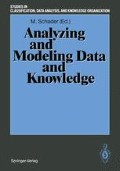Abstract
This paper deals with some common problems in connection with classification procedures in social research. First, an abstract model is shown on which most surveys are based. A number of classification tasks can be deduced from this model. However, classification procedures are rarely applied. The reason for this is discussed in the second part of the paper. The paradigma of structural equation models shows why some well known problems of numerical classification are evaluated negatively and hence classification procedures are rarely used. However, it is too easy to explain the rare use of classification by this paradigma only. Another important reason is the negligence of measurement errors. The standard statistical packages, like BMDP, SAS and SPSS-X, do not contain classification procedures that allow an estimation of measurement errors. The third part shows that latent class analysis and multivariate mixture models can be interpreted as classification procedures which make allowance for measurement errors.
Access this chapter
Tax calculation will be finalised at checkout
Purchases are for personal use only
Preview
Unable to display preview. Download preview PDF.
References
BACHER, J. (1989), Einführung in die Clusteranalyse mit SPSS-X für Historiker und Sozialwissenschafter. Historcial Social Research Vol. 14, 6–167.
BACHER, J. (1990), Einführung in die Logik der Skalierungsverfahren. Historical Social Research Vol. 15, 4–170.
BARDELEBEN, H. (1987), CONCLUS. Gießen.
BENTLER, P.M. (1983), Theory and Implentation of EQS, a Structural Equation Program. Los Angeles: BMDP Statistical Software.
CALINSKI, T., and HARABASZ, J. (1974), A Dendrite Method for Cluster Analysis. Communications in Statistics, 13, 1–27.
DENZ, H. (1989), Einführung in die empirische Sozialforschung. Wien-New York.
DIXON, W.J. (1983), BMDP Statistical Software. 1983 Printing with Additions. Berkeley-Los Angeles-London.
DUDA, R.O., and HART, P.E. (1973), Pattern Classification and Scene Analysis. New York.
HOLM, K. (1976), Die Faktorenanalyse, in: K. HOLM (Ed.), Die Befragung 3. München, 11–268.
INGLEHART, R. (1979), Wertewandel in den westlichen Gesellschaften, in: H. KLAGES and P. KMIECIAK (Eds.), Wertewandel und gesellschaftlicher Wandel. Frankfurt a.M.-New York, 279–316.
JORESKOG, K.D., and SORBOM, D. (1984), LISREL VI. Analysis of Linear Structural Relationship by the Method of Maximum Likelihood. Uppsala.
KAUFMANN, H., and PAPE, H. (1984), Clusteranalyse, in: L. FAHRMEIR and A. HAMMERLE (Eds.), Multivariate statistische Analyseverfahren. Berlin-New York, 371–472.
KUHN, T. (1968), Die Struktur wissenschaftlicher Revolutionen. Frankfurt a.M. LAZARSFELD, P.F., and HENRY, N.W. (1968), Latent Structure Analysis. New York.
LORD, F.M., and NOVICK, M.R. (1968), Statistical Test Theory of Mental Test Scores. New York.
MOJENA, A. (1977), Hierachical Grouping Methods and Stopping Rules-An Evaluation. Computer Journal Vol. 20, 359–363.
PFEIFER, A., and SCHMIDT, P. (1987), LISREL. Die Analyse komplexer Strukturgleichungsmodelle. Stuttgart.
SAS INSTITUTE INC. (1988), SAS/STAT User’s Guide. Cary NC.
SCHLOSSER, O. (1976), Einführung in die sozialwissenschaftliche Zusammenhangsanalyse. Reinbek bei Hamburg.
SPSS INC. (1986), SPSS-X User’s Guide. Chicago.
SPSS INC. (1985), SPSS Statistical Algorithms. Chicago.
STEINHAUSEN, D., and LANGER, K. (1977), Clusteranalyse. Einführung in die Methoden und Verfahren der automatischen Klassifikation. Berlin-New York.
WISHART, D. (1984), CLUSTAN. Benutzerhandbuch. 3. Ausgabe. Stuttgart-New York.
Author information
Authors and Affiliations
Editor information
Editors and Affiliations
Rights and permissions
Copyright information
© 1992 Springer-Verlag Berlin · Heidelberg
About this paper
Cite this paper
Bacher, J. (1992). Some Common Problems in the Use of Classification Procedures in Social Sciences. In: Schader, M. (eds) Analyzing and Modeling Data and Knowledge. Studies in Classification, Data Analysis, and Knowledge Organization. Springer, Berlin, Heidelberg. https://doi.org/10.1007/978-3-642-46757-8_26
Download citation
DOI: https://doi.org/10.1007/978-3-642-46757-8_26
Publisher Name: Springer, Berlin, Heidelberg
Print ISBN: 978-3-540-54708-2
Online ISBN: 978-3-642-46757-8
eBook Packages: Springer Book Archive

